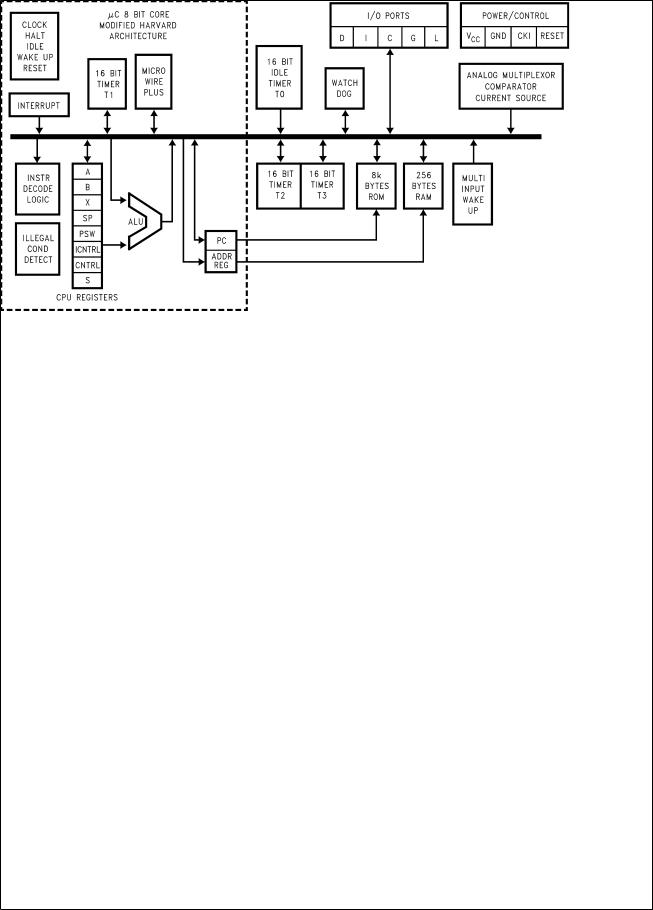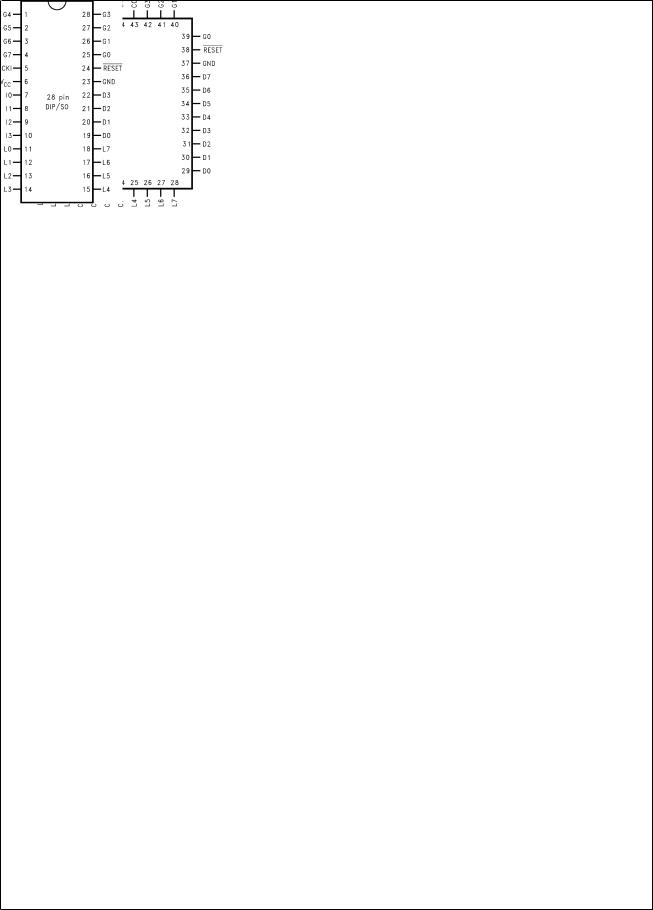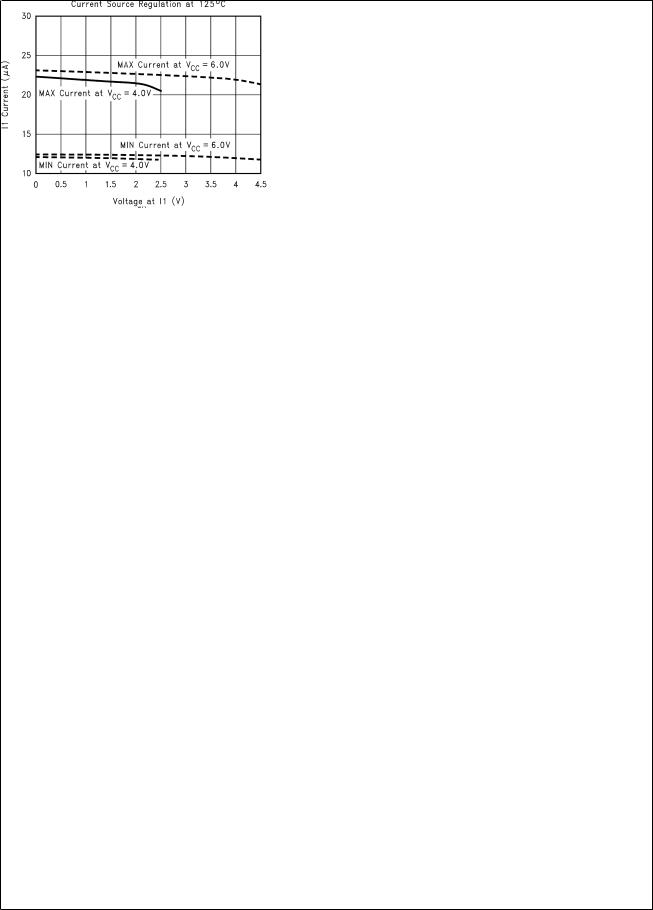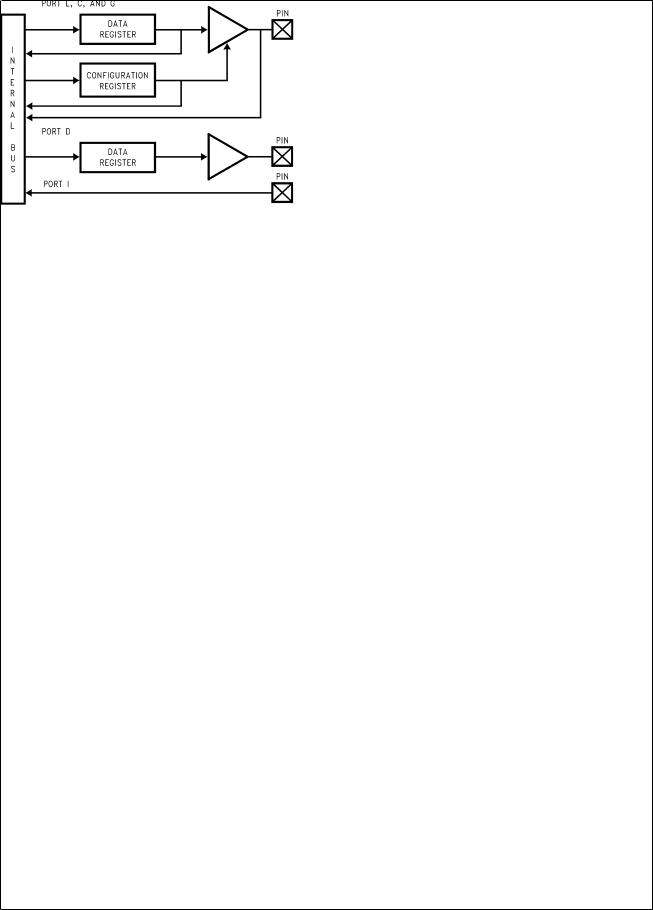NSC COPEK988V, COPEK988N, COPEK984N, COPEK888V, COPEK888N Datasheet
...
OBSOLETE
January 2000
COP888EK
8-Bit CMOS ROM Based Microcontrollers with 8k Memory, Comparator, and Single-slope A/D Capability
General Description
The COP888EK ROM based microcontrollers are highly integrated COP8™ Feature core devices with 8k memory and advanced features including a Multi-Input Comparator and Single-slope A/D capability. These single-chip CMOS devices are suited for applications requiring a full featured, low EMI controller with an analog comparator, current source, and voltage reference. The COP87L88EK/RK Family devices are pin and software compatible (different VCC range) 16k or 32k OTP (One Time Programmable) versions for preproduction, and for use with a range of COP8 software and hardware development tools.
Family features include an 8-bit memory mapped architecture, 10 MHz CKI with 1µs instruction cycle, three multifunction 16-bit timer/counters with PWM, MICROWIRE/ PLUS™ serial I/O, one analog comparator with seven input multiplexor, an analog current source and VCC reference, two power saving HALT/IDLE modes, idle timer, MIWU, high current outputs, software selectable I/O options, WATCHDOG™ timer and Clock Monitor, Low EMI 2.5V to 6.0V operation and 28/40/44 pin packages.
Devices included in this datasheet are:
Device |
Memory (bytes) |
RAM (bytes) |
I/O Pins |
|
Packages |
Temperature |
|
Comments |
|
|
|
|
|
|
|
|
|
COP684EK |
8k ROM |
256 |
24 |
28 |
DIP/SOIC |
-55 to +125ÊC |
4.5V |
- 5.5V |
COP884EK |
8k ROM |
256 |
24 |
28 |
DIP/SOIC |
-40 to +85ÊC |
|
|
COP984EK |
8k ROM |
256 |
24 |
28 |
DIP/SOIC |
0 to +70ÊC |
2.5V |
- 4.0V, EKH=4.0V - 6.0V |
COP688EK |
8k ROM |
256 |
36/40 |
40 |
DIP, 44 PLCC |
-55 to +125ÊC |
4.5V |
- 5.5V |
COP888EK |
8k ROM |
256 |
36/40 |
40 |
DIP, 44 PLCC |
-40 to +85ÊC |
|
|
COP988EK |
8k ROM |
256 |
36/40 |
40 |
DIP, 44 PLCC |
0 to +70ÊC |
2.5V |
- 4.0V, EKH=4.0V - 6.0V |
|
|
|
|
|
|
|
|
|
Key Features
nAnalog function block with
ÐAnalog comparator with seven input multiplexor
ÐConstant current source and V CC/2 reference
nThree 16-bit timers, each with two 16-bit registers supporting:
ÐProcessor Independent PWM mode
ÐExternal Event counter mode
ÐInput Capture mode
n8 kbytes of on-chip ROM
n256 bytes of on-chip RAM
Additional Peripheral Features
nIdle Timer
nMulti-Input Wake Up (MIWU) with optional interrupts (8)
nWATCHDOG and Clock Monitor logic
nMICROWIRE/PLUS serial I/O
I/O Features
nSoftware selectable I/O options (TRI-STATE™ Output, Push-Pull Output, Weak Pull-Up Input, High Impedance Input)
nHigh current outputs
nSchmitt trigger inputs on Port G and L
nPackages: 44 PLCC with 40 I/O pins, 40 DIP with 36 I/O pins, and 28 DIP/SO with 24 I/O pins
CPU/Instruction Set Feature
n1 µs instruction cycle time
nTwelve multi-source vectored interrupts servicing
ÐExternal Interrupt with selectable edge
ÐIdle Timer T0
ÐThree Timers (Each with 2 interrupts)
ÐMICROWIRE/PLUS
ÐMulti-Input Wake Up
ÐSoftware Trap
ÐDefault VIS (default interrupt)
nVersatile and easy to use instruction set
n8-bit Stack Pointer (SP) Ð stack in RAM
nTwo 8-bit Register Indirect Data Memory Pointers (B, X)
Fully Static CMOS
nSingle supply operation: 2.5V to 6.0V
nTemperature ranges: 0ÊC to +70ÊC, −40ÊC to +85ÊC, and −55ÊC to +125ÊC
COP8™ , MICROWIRE/PLUS™ , and WATCHDOG™ are trademarks of National Semiconductor Corporation. TRI-STATE® is a registered trademark of National Semiconductor Corporation.
iceMASTER® is a registered trademark of MetaLink Corporation.
slope-Single |
8 COP888EK |
A/D |
Bit- |
Capability |
ROM CMOS |
|
and Comparator, Memory, 8k with Microcontrollers Based |
© 2000 National Semiconductor Corporation |
DS012094 |
www.national.com |

COP888EK
Development Support |
n Real time emulation and full program debug offered by |
|
n Emulation and OTP devices |
MetaLink Development System |
|
|
||
|
|
|
Block Diagram |
|
|
DS012094-1
FIGURE 1. Block Diagram
www.national.com |
2 |

Connection Diagrams
Plastic Chip Carrier |
Dual-In-Line Package |
|
DS012094-2
Top View
Order Number COP688EK-XXX/V, COP888EK-XXX/V,
COP988EK-XXX/V or COP988EKH-XXX/V
See NS Plastic Chip Package Number V44A
DS012094-3
Top View
Order Number COP688EK-XXX/N, COP888EK-XXX/N,
COP988EK-XXX/N or COP988EKH-XXX/N
See NS Molded Package Number N40A
Dual-In-Line Package
DS012094-4
Top View
Order Number COP684EK-XXX/N, COP884EK-XXX/N, COP984EK-XXX/N or COP984EKH-XXX/N See NS Molded Package Number N28B
Order Number COP684EK-XXX/WM, COP884EK-XXX/WM, COP984EK-XXX/WM or COP984EKH-XXX/WM See NS Molded Package Number M28B
FIGURE 2. Connection Diagrams
COP888EK
3 |
www.national.com |

COP888EK
Connection Diagrams (Continued)
Pinouts for 28-, 40and 44-Pin Packages
|
Port |
Type |
Alt. Fun |
Alt. Fun |
28-Pin |
40-Pin |
44-Pin |
|
|
Pack. |
Pack. |
Pack. |
|||||
|
|
|
|
|
|
|||
|
|
|
|
|
|
|
|
|
|
L0 |
I/O |
MIWU |
|
11 |
17 |
17 |
|
|
L1 |
I/O |
MIWU |
|
12 |
18 |
18 |
|
|
L2 |
I/O |
MIWU |
|
13 |
19 |
19 |
|
|
L3 |
I/O |
MIWU |
|
14 |
20 |
20 |
|
|
L4 |
I/O |
MIWU |
T2A |
15 |
21 |
25 |
|
|
L5 |
I/O |
MIWU |
T2B |
16 |
22 |
26 |
|
|
L6 |
I/O |
MIWU |
T3A |
17 |
23 |
27 |
|
|
L7 |
I/O |
MIWU |
T3B |
18 |
24 |
28 |
|
|
|
|
|
|
|
|
|
|
|
G0 |
I/O |
INT |
|
25 |
35 |
39 |
|
|
G1 |
WDOUT |
|
|
26 |
36 |
40 |
|
|
G2 |
I/O |
T1B |
|
27 |
37 |
41 |
|
|
G3 |
I/O |
T1A |
|
28 |
38 |
42 |
|
|
G4 |
I/O |
SO |
|
1 |
3 |
3 |
|
|
G5 |
I/O |
SK |
|
2 |
4 |
4 |
|
|
G6 |
I |
SI |
|
3 |
5 |
5 |
|
|
G7 |
I/CKO |
HALT Restart |
|
4 |
6 |
6 |
|
|
|
|
|
|
|
|
|
|
|
D0 |
O |
|
|
19 |
25 |
29 |
|
|
D1 |
O |
|
|
20 |
26 |
30 |
|
|
D2 |
O |
|
|
21 |
27 |
31 |
|
|
D3 |
O |
|
|
22 |
28 |
32 |
|
|
|
|
|
|
|
|
|
|
|
I0 |
I |
COMPIN1+ |
|
7 |
9 |
9 |
|
|
I1 |
I |
COMPIN−/Current |
|
8 |
10 |
10 |
|
|
|
|
|
Source Out |
|
|
|
|
|
I2 |
I |
COMPIN0+ |
|
9 |
11 |
11 |
|
|
I3 |
I |
COMPOUT/COMPIN2+ |
|
10 |
12 |
12 |
|
|
|
|
|
|
|
|
|
|
|
I4 |
I |
COMPIN3+ |
|
|
13 |
13 |
|
|
I5 |
I |
COMPIN4+ |
|
|
14 |
14 |
|
|
I6 |
I |
COMPIN5+ |
|
|
15 |
15 |
|
|
I7 |
I |
COMPOUT |
|
|
16 |
16 |
|
|
|
|
|
|
|
|
|
|
|
D4 |
O |
|
|
|
29 |
33 |
|
|
D5 |
O |
|
|
|
30 |
34 |
|
|
D6 |
O |
|
|
|
31 |
35 |
|
|
D7 |
O |
|
|
|
32 |
36 |
|
|
|
|
|
|
|
|
|
|
|
C0 |
I/O |
|
|
|
39 |
43 |
|
|
C1 |
I/O |
|
|
|
40 |
44 |
|
|
C2 |
I/O |
|
|
|
1 |
1 |
|
|
C3 |
I/O |
|
|
|
2 |
2 |
|
|
C4 |
I/O |
|
|
|
|
21 |
|
|
C5 |
I/O |
|
|
|
|
22 |
|
|
C6 |
I/O |
|
|
|
|
23 |
|
|
C7 |
I/O |
|
|
|
|
24 |
|
|
|
|
|
|
|
|
|
|
|
VCC |
|
|
|
6 |
8 |
8 |
|
|
GND |
|
|
|
23 |
33 |
37 |
|
|
CKI |
|
|
|
5 |
7 |
7 |
|
|
|
|
|
|
24 |
34 |
38 |
|
|
RESET |
|
|
|
|
|||
www.national.com |
4 |

Absolute Maximum Ratings (Note 1)
If Military/Aerospace specified devices are required, please contact the National Semiconductor Sales Office/ Distributors for availability and specifications.
Supply Voltage (VCC) |
7V |
Voltage at Any Pin |
−0.3V to V CC + 0.3V |
Total Current into VCC Pin (Source) |
100 mA |
Total Current out of GND Pin (Sink) |
110 mA |
Storage Temperature Range |
−65ÊC to +140ÊC |
Note 1: Absolute maximum ratings indicate limits beyond which damage to the device may occur. DC and AC electrical specifications are not ensured when operating the device at absolute maximum ratings.
DC Electrical Characteristics 98xEK:
0ÊC ≤ TA ≤ + 70ÊC unless otherwise specified
|
|
Parameter |
Conditions |
Min |
Typ |
Max |
Units |
|
|
|
|
|
|
|
|
|
Operating Voltage COP98XEK |
|
2.5 |
|
4.0 |
V |
|
|
COP98XEKH |
|
4.0 |
|
6.0 |
V |
|
|
Power Supply Ripple (Note 3) |
Peak-to-Peak |
|
|
0.1 VCC |
V |
|
|
Supply Current (Note 4) |
|
|
|
|
|
|
|
CKI = 10 MHz |
VCC = 6.0V, tc = 1 µs |
|
|
10.0 |
mA |
|
|
CKI = 4 MHz |
VCC = 2.5V, tc = 2.5 µs |
|
|
1.7 |
mA |
|
|
HALT Current (Note 5) |
VCC = 6.0V, CKI = 0 MHz |
|
<4 |
8 |
µA |
|
|
|
|
VCC = 4.0V, CKI = 0 MHz |
|
<3 |
4 |
µA |
|
IDLE Current (Note 4) |
|
|
|
|
|
|
|
CKI = 10 MHz |
VCC = 6.0V, tc = 1 µs |
|
0.4 |
1.7 |
mA |
|
|
CKI = 4 MHz |
VCC = 2.5V, tc = 2.5 µs |
|
0.2 |
0.5 |
mA |
|
|
Input Levels (VIH, VIL) |
|
|
|
|
|
|
|
|
|
|
|
|
|
|
|
RESET |
|
|
|
|
|
|
|
Logic High |
|
0.8 VCC |
|
|
V |
|
|
Logic Low |
|
|
|
0.2 VCC |
V |
|
|
CKI, All Other Inputs |
|
|
|
|
|
|
|
Logic High |
|
0.7 VCC |
|
|
V |
|
|
Logic Low |
|
|
|
0.2 VCC |
V |
|
|
Hi-Z Input Leakage |
VCC = 6.0V |
−1 |
|
+1 |
µA |
|
|
Input Pullup Current |
VCC = 6.0V, VIN = 0V |
−40 |
|
−250 |
µA |
|
|
G and L Port Input Hysteresis (Note 8) |
|
|
|
0.35 VCC |
V |
|
|
Output Current Levels |
|
|
|
|
|
|
|
D Outputs |
|
|
|
|
|
|
|
Source |
VCC = 4.0V, VOH = 3.3V |
−0.4 |
|
|
mA |
|
|
|
|
VCC = 2.5V, VOH = 1.8V |
−0.2 |
|
|
mA |
|
Sink |
VCC = 4.0V, VOL = 1V |
10 |
|
|
mA |
|
|
|
|
VCC = 2.5V, VOL = 0.4V |
2.0 |
|
|
mA |
|
All Others |
|
|
|
|
|
|
|
Source (Weak Pull-Up Mode) |
VCC = 4.0V, VOH = 2.7V |
−10 |
|
−110 |
µA |
|
|
|
|
VCC = 2.5V, VOH = 1.8V |
−2.5 |
|
−33 |
µA |
|
Source (Push-Pull Mode) |
VCC = 4.0V, VOH = 3.3V |
−0.4 |
|
|
mA |
|
|
|
|
VCC = 2.5V, VOH = 1.8V |
−0.2 |
|
|
mA |
|
Sink (Push-Pull Mode) |
VCC = 4.0V, VOL = 0.4V |
1.6 |
|
|
mA |
|
|
|
|
VCC = 2.5V, VOL = 0.4V |
0.7 |
|
|
mA |
|
TRI-STATE Leakage |
VCC = 6.0V |
−1 |
|
+1 |
µA |
|
|
Allowable Sink/Source Current per Pin |
|
|
|
|
|
|
|
(Note 8) |
|
|
|
|
|
|
|
D Outputs (Sink) |
|
|
|
15 |
mA |
|
|
All others |
|
|
|
3 |
mA |
|
|
|
|
|
|
|
|
|
|
Maximum Input Current |
Room Temp |
|
|
±100 |
mA |
|
|
without Latchup (Note 6) |
|
|
|
|
|
|
|
|
|
|
|
|
|
|
|
RAM Retention Voltage, Vr |
500 ns Rise and Fall Time (Min) |
2 |
|
|
V |
|
COP888EK
5 |
www.national.com |

COP888EK
DC Electrical Characteristics 98xEK: (Continued)
0ÊC £ TA £ + 70ÊC unless otherwise specified
Parameter |
Conditions |
Min |
Typ |
Max |
Units |
|
|
|
|
|
|
Input Capacitance |
|
|
|
7 |
pF |
|
|
|
|
|
|
Load Capacitance on D2 |
|
|
|
1000 |
pF |
|
|
|
|
|
|
AC Electrical Characteristics 98xEK:
0ÊC £ TA£ + 70ÊC unless otherwise specified
Parameter |
|
Conditions |
Min |
Typ |
Max |
Units |
|
|
|
|
|
|
|
Instruction Cycle Time (tc) |
|
|
|
|
|
|
Crystal, Resonator, |
4.0V |
£ VCC £ 6.0V |
1.0 |
|
DC |
µs |
|
2.5V |
£ VCC < 4.0V |
2.5 |
|
DC |
µs |
R/C Oscillator |
4.0V |
£ VCC £ 6.0V |
3.0 |
|
DC |
µs |
|
2.5V |
£ VCC < 4.0V |
7.5 |
|
DC |
µs |
Inputs |
|
|
|
|
|
|
tSETUP |
4.0V |
£ VCC £ 6.0V |
200 |
|
|
ns |
|
2.5V |
£ VCC < 4.0V |
500 |
|
|
ns |
tHOLD |
4.0V |
£ VCC £ 6.0V |
60 |
|
|
ns |
|
2.5V |
£ VCC < 4.0V |
150 |
|
|
ns |
Output Propagation Delay (Note 7) |
RL = 2.2k, CL = 100 pF |
|
|
|
|
|
tPD1, tPD0 |
|
|
|
|
|
|
SO, SK |
4.0V |
£ VCC £ 6.0V |
|
|
0.7 |
µs |
|
2.5V |
£ VCC < 4.0V |
|
|
1.75 |
µs |
All Others |
4.0V |
£ VCC £ 6.0V |
|
|
1 |
µs |
|
2.5V |
£ VCC < 4.0V |
|
|
2.5 |
µs |
MICROWIRE™ Setup Time (tUWS) (Note 7) |
VCC ³ 4.0V |
20 |
|
|
ns |
|
MICROWIRE Hold Time (tUWH) (Note 7) |
VCC ³ 4.0V |
56 |
|
|
ns |
|
MICROWIRE Output Propagation Delay (tUPD) |
VCC ³ 4.0V |
|
|
220 |
ns |
|
Input Pulse Width (Note 8) |
|
|
|
|
|
|
Interrupt Input High Time |
|
|
1.0 |
|
|
tc |
Interrupt Input Low Time |
|
|
1.0 |
|
|
tc |
Timer 1, 2, 3 Input High Time |
|
|
1.0 |
|
|
tc |
Timer 1, 2, 3 Input Low Time |
|
|
1.0 |
|
|
tc |
Reset Pulse Width |
|
|
1.0 |
|
|
µs |
|
|
|
|
|
|
|
Note 2: tc = Instruction Cycle Time
Note 3: Maximum rate of voltage change must be < 0.5 V/ms.
Note 4: Supply and IDLE currents are measured with CKI driven with a square wave Oscillator, CKO driven 180Ê out of phase with CKI, inputs connected to VCC and outputs driven low but not connected to a load.
Note 5: The HALT mode will stop CKI from oscillating in the RC and the Crystal configurations. Measurement of IDD HALT is done with device neither sourcing nor sinking current; with L, C, and G0±G5 programmed as low outputs and not driving a load; all outputs programmed low and not driving a load; all inputs tied to VCC; clock monitor and comparator disabled. Parameter refers to HALT mode entered via setting bit 7 of the G Port data register. Part will pull up CKI during HALT in crystal clock mode.
Note 6: Pins G6 and RESET are designed with a high voltage input network. These pins allow input voltages > VCC and the pins will have sink current to VCC when biased at voltages > VCC(the pins do not have source current when biased at a voltage below VCC). The effective resistance to VCC is 750Ω (typical). These two pins will not latch up. The voltage at the pins must be limited to < 14V. WARNING: Voltages in excess of 14V will cause damage to the pins. This warning excludes ESD transients.
Note 7: The output propagation delay is referenced to the end of the instruction cycle where the output change occurs.
Note 8: Parameter characterized but not tested.
www.national.com |
6 |

Absolute Maximum Ratings (Note 9)
If Military/Aerospace specified devices are required, please contact the National Semiconductor Sales Office/ Distributors for availability and specifications.
Supply Voltage (VCC) |
7V |
Voltage at Any Pin |
−0.3V to V CC + 0.3V |
Total Current into VCC Pin (Source) |
100 mA |
Total Current out of GND Pin (Sink) |
110 mA |
Storage Temperature Range |
−65ÊC to +140ÊC |
Note 9: Absolute maximum ratings indicate limits beyond which damage to the device may occur. DC and AC electrical specifications are not ensured when operating the device at absolute maximum ratings.
DC Electrical Characteristics 88xEK:
−40ÊC ≤ TA ≤ +85ÊC unless otherwise specified
|
|
Parameter |
Conditions |
Min |
Typ |
Max |
Units |
|
|
|
|
|
|
|
|
|
Operating Voltage |
|
2.5 |
|
6.0 |
V |
|
|
Power Supply Ripple (Note 11) |
Peak-to-Peak |
|
|
0.1 VCC |
V |
|
|
Supply Current (Note 12) |
|
|
|
|
|
|
|
CKI = 10 MHz |
VCC = 6.0V, tc = 1 µs |
|
|
10.0 |
mA |
|
|
CKI = 4 MHz |
VCC = 2.5V, tc = 2.5 µs |
|
|
1.7 |
mA |
|
|
HALT Current (Note 13) |
VCC = 6.0V, CKI = 0 MHz |
|
<4 |
10 |
µA |
|
|
IDLE Current (Note 12) |
|
|
|
|
|
|
|
CKI = 10 MHz |
VCC = 6.0V, tc = 1 µs |
|
0.4 |
1.7 |
mA |
|
|
CKI = 4 MHz |
VCC = 6.0V, tc = 2.5 µs |
|
0.2 |
0.5 |
mA |
|
|
Input Levels (VIH, VIL) |
|
|
|
|
|
|
|
|
|
|
|
|
|
|
|
RESET |
|
|
|
|
|
|
|
Logic High |
|
0.8 VCC |
|
|
V |
|
|
Logic Low |
|
|
|
0.2 VCC |
V |
|
|
CKI, All Other Inputs |
|
|
|
|
|
|
|
Logic High |
|
0.7 VCC |
|
|
V |
|
|
Logic Low |
|
|
|
0.2 VCC |
V |
|
|
Hi-Z Input Leakage |
VCC = 6.0V |
−2 |
|
+2 |
µA |
|
|
Input Pullup Current |
VCC = 6.0V, VIN = 0V |
−40 |
|
−250 |
µA |
|
|
G and L Port Input Hysteresis (Note 16) |
|
|
|
0.35 VCC |
V |
|
|
Output Current Levels |
|
|
|
|
|
|
|
D Outputs |
|
|
|
|
|
|
|
Source |
VCC = 4.0V, VOH = 3.3V |
−0.4 |
|
|
mA |
|
|
|
|
VCC = 2.5V, VOH = 1.8V |
−0.2 |
|
|
mA |
|
Sink |
VCC = 4.0V, VOL = 1V |
10 |
|
|
mA |
|
|
|
|
VCC = 2.5V, VOL = 0.4V |
2.0 |
|
|
mA |
|
All Others |
|
|
|
|
|
|
|
Source (Weak Pull-Up Mode) |
VCC = 4.0V, VOH = 2.7V |
−10 |
|
−100 |
µA |
|
|
|
|
VCC = 2.5V, VOH = 1.8V |
−2.5 |
|
−33 |
µA |
|
Source (Push-Pull Mode) |
VCC = 4.0V, VOH = 3.3V |
−0.4 |
|
|
mA |
|
|
|
|
VCC = 2.5V, VOH = 1.8V |
−0.2 |
|
|
mA |
|
Sink (Push-Pull Mode) |
VCC = 4.0V, VOL = 0.4V |
1.6 |
|
|
mA |
|
|
|
|
VCC = 2.5V, VOL = 0.4V |
0.7 |
|
|
mA |
|
TRI-STATE Leakage |
VCC = 6.0V |
−2 |
|
+2 |
µA |
|
|
Allowable Sink/Source Current per Pin |
|
|
|
|
|
|
|
(Note 16) |
|
|
|
|
|
|
|
D Outputs (Sink) |
|
|
|
15 |
mA |
|
|
All others |
|
|
|
3 |
mA |
|
|
|
|
|
|
|
|
|
|
Maximum Input Current |
Room Temp |
|
|
±100 |
mA |
|
|
without Latchup (Note 14) |
|
|
|
|
|
|
|
|
|
|
|
|
|
|
|
RAM Retention Voltage, Vr |
500 ns Rise |
2 |
|
|
V |
|
|
|
|
and Fall Time (min) |
|
|
|
|
|
|
|
|
|
|
|
|
|
Input Capacitance |
|
|
|
7 |
pF |
|
|
|
|
|
|
|
|
|
COP888EK
7 |
www.national.com |

COP888EK
DC Electrical Characteristics 88xEK: (Continued)
−40ÊC ≤ TA ≤ +85ÊC unless otherwise specified
Parameter |
Conditions |
Min |
Typ |
Max |
Units |
|
|
|
|
|
|
Load Capacitance on D2 |
|
|
|
1000 |
pF |
|
|
|
|
|
|
AC Electrical Characteristics 88xEK:
−40ÊC ≤ TA ≤ +85ÊC unless otherwise specified
Parameter |
|
Conditions |
Min |
Typ |
Max |
Units |
|
|
|
|
|
|
|
Instruction Cycle Time (tc) |
|
|
|
|
|
|
Crystal, Resonator, |
4.0V |
≤ VCC ≤ 6.0V |
1.0 |
|
DC |
µs |
|
2.5V |
≤ VCC < 4.0V |
2.5 |
|
DC |
µs |
R/C Oscillator |
4.0V |
≤ VCC ≤ 6.0V |
3.0 |
|
DC |
µs |
|
2.5V |
≤ VCC ≤ 4.0V |
7.5 |
|
DC |
µs |
Inputs |
|
|
|
|
|
|
tSETUP |
4.0V |
≤ VCC ≤ 6.0V |
200 |
|
|
ns |
|
2.5V |
≤ VCC < 4.0V |
500 |
|
|
ns |
tHOLD |
4.0V |
≤ VCC ≤ 6.0V |
60 |
|
|
ns |
|
2.5V |
≤ VCC < 4.0V |
150 |
|
|
ns |
Output Propagation Delay (Note 15) |
RL = 2.2k, CL = 100 pF |
|
|
|
|
|
tPD1, tPD0 |
|
|
|
|
|
|
SO, SK |
4.0V |
≤ VCC ≤ 6.0V |
|
|
0.7 |
µs |
|
2.5V |
≤ VCC < 4.0V |
|
|
1.75 |
µs |
All Others |
4.0V |
≤ VCC ≤ 6.0V |
|
|
1.0 |
µs |
|
2.5V |
≤ VCC < 4.0V |
|
|
2.5 |
µs |
MICROWIRE Setup Time (tUWS) (Note 15) |
|
|
20 |
|
|
ns |
MICROWIRE Hold Time (tUWH) (Note 15) |
|
|
56 |
|
|
ns |
MICROWIRE Output Propagation Delay (tUPD) |
|
|
|
|
220 |
ns |
Input Pulse Width (Note 16) |
|
|
|
|
|
|
Interrupt Input High Time |
|
|
1.0 |
|
|
tc |
Interrupt Input Low Time |
|
|
1.0 |
|
|
tc |
Timer 1, 2, 3 Input High Time |
|
|
1.0 |
|
|
tc |
Timer 1, 2, 3 Input Low Time |
|
|
1.0 |
|
|
tc |
Reset Pulse Width |
|
|
1.0 |
|
|
µs |
|
|
|
|
|
|
|
Note 10: tc = Instruction Cycle Time
Note 11: Maximum rate of voltage change must be < 0.5 V/ms.
Note 12: Supply and IDLE currents are measured with CKI driven with a square wave Oscillator, CKO driven 180Ê out of phase with CKI, inputs connected to VCC and outputs driven low but not connected to a load.
Note 13: The HALT mode will stop CKI from oscillating in the RC and the Crystal configurations. Measurement of IDD HALT is done with device neither sourcing nor sinking current; with L, C, G0, and G2±G5 programmed as low outputs and not driving a load; all outputs programmed low and not driving a load; all inputs tied to VCC; clock monitor and comparator disabled. Parameter refers to HALT mode entered via setting bit 7 of the G Port data register. Part will pull up CKI during HALT in crystal clock mode.
Note 14: Pins G6 and RESET are designed with a high voltage input network. These pins allow input voltages > VCC and the pins will have sink current to VCC when biased at voltages > VCC(the pins do not have source current when biased at a voltage below VCC). The effective resistance to VCC is 750Ω (typical). These two pins will not latch up. The voltage at the pins must be limited to < 14V. WARNING: Voltages in excess of 14V will cause damage to the pins. This warning excludes ESD transients.
Note 15: The output propagation delay is referenced to the end of the instruction cycle where the output change occurs.
Note 16: Parameter characterized but not tested.
www.national.com |
8 |

Absolute Maximum Ratings (Note 17)
If Military/Aerospace specified devices are required, please contact the National Semiconductor Sales Office/ Distributors for availability and specifications.
Supply Voltage (VCC) |
7V |
Voltage at Any Pin |
−0.3V to V CC + 0.3V |
Total Current into VCC Pin (Source) |
100 mA |
Total Current out of GND Pin (Sink) |
110 mA |
Storage Temperature Range |
−65ÊC to +140ÊC |
Note 17: Absolute maximum ratings indicate limits beyond which damage to the device may occur. DC and AC electrical specifications are not ensured when operating the device at absolute maximum ratings.
DC Electrical Characteristics 68xEK:
−55ÊC ≤ TA ≤ +125ÊC unless otherwise specified
|
|
Parameter |
Conditions |
Min |
Typ |
Max |
Units |
|
|
|
|
|
|
|
|
|
Operating Voltage |
|
4.5 |
|
5.5 |
V |
|
|
Power Supply Ripple (Note 19) |
Peak-to-Peak |
|
|
0.1 VCC |
V |
|
|
Supply Current (Note 22) |
VCC = 5.5V, tc = 1 µs |
|
|
12.5 |
mA |
|
|
CKI = 10 MHz |
|
|
|
|
|
|
|
|
|
|
|
|
|
|
|
HALT Current (Note 21) |
VCC = 5.5V, CKI = 0 MHz |
|
<10 |
30 |
µA |
|
|
IDLE Current (Note 22) |
|
|
|
|
|
|
|
CKI = 10 MHz |
VCC = 5.5V, tc = 1 µs |
|
|
1.7 |
mA |
|
|
Input Levels (VIH, VIL) |
|
|
|
|
|
|
|
|
|
|
|
|
|
|
|
RESET |
|
|
|
|
|
|
|
Logic High |
|
0.8 VCC |
|
|
V |
|
|
Logic Low |
|
|
|
0.2 VCC |
V |
|
|
CKI, All Other Inputs |
|
|
|
|
|
|
|
Logic High |
|
0.7 VCC |
|
|
V |
|
|
Logic Low |
|
|
|
0.2 VCC |
V |
|
|
Hi-Z Input Leakage |
VCC = 5.5V |
−5 |
|
+5 |
µA |
|
|
Input Pullup Current |
VCC = 5.5V, VIN = 0V |
−35 |
|
−400 |
µA |
|
|
G and L Port Input Hysteresis (Note 24) |
|
|
|
0.35 VCC |
V |
|
|
Output Current Levels |
|
|
|
|
|
|
|
D Outputs |
|
|
|
|
|
|
|
Source |
VCC = 4.5V, VOH = 3.3V |
−0.4 |
|
|
mA |
|
|
Sink |
VCC = 4.5V, VOL = 1.0V |
9.0 |
|
|
mA |
|
|
All Others |
|
|
|
|
|
|
|
Source (Weak Pull-Up Mode) |
VCC = 4.5V, VOH = 2.7V |
−9.0 |
|
−110 |
µA |
|
|
Source (Push-Pull Mode) |
VCC = 4.5V, VOH = 3.3V |
−0.4 |
|
|
mA |
|
|
Sink (Push-Pull Mode) |
VCC = 4.5V, VOL = 0.4V |
1.6 |
|
|
mA |
|
|
TRI-STATE Leakage |
VCC = 5.5V |
−5.0 |
|
+5 |
µA |
|
|
Allowable Sink/Source Current per Pin |
|
|
|
|
|
|
|
D Outputs (Sink) |
|
|
|
12 |
mA |
|
|
All others |
|
|
|
2.5 |
mA |
|
|
|
|
|
|
|
|
|
|
Maximum Input Current |
Room Temp |
|
|
±100 |
mA |
|
|
without Latchup (Note 22) |
|
|
|
|
|
|
|
|
|
|
|
|
|
|
|
RAM Retention Voltage, Vr |
500 ns Rise and |
2 |
1.5 |
|
V |
|
|
|
|
and Fall Time (min) |
|
|
|
|
|
|
|
|
|
|
|
|
|
Input Capacitance |
|
|
|
7 |
pF |
|
|
|
|
|
|
|
|
|
|
Load Capacitance on D2 |
|
|
|
1000 |
pF |
|
|
|
|
|
|
|
|
|
COP888EK
9 |
www.national.com |

COP888EK
AC Electrical Characteristics 68xEK:
−55ÊC £ TA £ +125ÊC unless otherwise specified
Parameter |
|
Conditions |
Min |
Typ |
Max |
Units |
|
|
|
|
|
|
|
Instruction Cycle Time (tc) |
|
|
|
|
|
|
Crystal, Resonator |
4.5V |
£ VCC £ 5.5V |
1.0 |
|
DC |
µs |
R/C Oscillator |
4.5V |
£ VCC < 5.5V |
3.0 |
|
DC |
µs |
Inputs |
|
|
|
|
|
|
tSETUP |
4.5V |
£ VCC £ 5.5V |
200 |
|
|
ns |
tHOLD |
4.5V |
£ VCC £ 5.5V |
60 |
|
|
ns |
Output Propagation Delay (Note 23) |
RL = 2.2k, CL = 100 pF |
|
|
|
|
|
tPD1, tPD0 |
|
|
|
|
|
|
SO, SK |
4.5V |
£ VCC £ 5.5V |
|
|
0.7 |
µs |
All Others |
4.5V |
£ VCC £ 5.5V |
|
|
1.0 |
µs |
MICROWIRE Setup Time (tUWS) (Note 23) |
VCC ³ 4.5V |
20 |
|
|
ns |
|
MICROWIRE Hold Time (tUWH) (Note 23) |
VCC ³ 4.5V |
56 |
|
|
ns |
|
MICROWIRE Output Propagation Delay (tUPD) |
VCC ³ 4.5V |
|
|
220 |
ns |
|
Input Pulse Width (Note 24) |
|
|
|
|
|
|
Interrupt Input High Time |
|
|
1.0 |
|
|
tc |
Interrupt Input Low Time |
|
|
1.0 |
|
|
tc |
Timer 1, 2, 3 Input High Time |
|
|
1.0 |
|
|
tc |
Timer 1, 2, 3 Input Low Time |
|
|
1.0 |
|
|
tc |
Reset Pulse Width |
|
|
1.0 |
|
|
µs |
|
|
|
|
|
|
|
Note 18: tc = Instruction Cycle Time
Note 19: Maximum rate of voltage change must be < 0.5 V/ms.
Note 20: Supply and IDLE currents are measured with CKI driven with a square wave Oscillator, CKO driven 180Ê out of phase with CKI, inputs connected to VCC and outputs driven low but not connected to a load.
Note 21: The HALT mode will stop CKI from oscillating in the RC and the Crystal configurations. Measurement of IDD HALT is done with device neither sourcing nor sinking current; with L, C, G0, and G2±G5 programmed as low outputs and not driving a load; all outputs programmed low and not driving a load; all inputs tied to VCC; clock monitor and comparator disabled. Parameter refers to HALT mode entered via setting bit 7 of the G Port data register. Part will pull up CKI during HALT in crystal clock mode.
Note 22: Pins G6 and RESET are designed with a high voltage input network. These pins allow input voltages > VCC and the pins will have sink current to VCC when biased at voltages > VCC(the pins do not have source current when biased at a voltage below VCC). The effective resistance to VCC is 750Ω (typical). These two pins will not latch up. The voltage at the pins must be limited to < 14V. WARNING: Voltages in excess of 14V will cause damage to the pins. This warning excludes ESD transients.
Note 23: The output propagation delay is referenced to the end of the instruction cycle where the output change occurs.
Note 24: Parameter characterized but not tested.
Analog Function Block AC and DC Characteristics
VCC = 5.0V, −40ÊC £ TA £ +85ÊC
Parameter |
|
Conditions |
Min |
Typ |
Max |
Units |
|
|
|
|
|
|
|
Input Offset Voltage |
0.4V |
< VIN < VCC − 1.5V |
|
±10 |
±25 |
mV |
Input Common Mode Voltage Range |
|
|
0.4 |
|
VCC − 1.5 |
V |
(Note 26) |
|
|
|
|
|
|
|
|
|
|
|
|
|
VCC/2 Reference |
4.0V |
< VCC < 6.0V |
0.5 VCC − 0.04 |
0.5 V CC |
0.5 VCC + 0.04 |
V |
DC Supply Current for |
VCC = 6.0V |
|
|
250 |
µA |
|
Comparator (when enabled) |
|
|
|
|
||
|
|
|
|
|
|
|
|
|
|
|
|
|
|
DC Supply Current for |
VCC = 6.0V |
|
50 |
80 |
µA |
|
VCC/2 Reference (when enabled) |
|
|
|
|
||
|
|
|
|
|
|
|
DC Supply Current for |
VCC = 6.0V |
|
|
200 |
µA |
|
Constant Current Source (when enabled) |
|
|
|
|
||
|
|
|
|
|
|
|
|
|
|
|
|
|
|
Constant Current Source |
4.0V |
< VCC < 6.0V |
10 |
20 |
40 |
µA |
Current Source Variation over |
4.0V |
< VCC < 6.0V |
|
|
±2 |
µA |
Common Mode Range |
Temp = Constant |
|
|
|
|
|
|
|
|
|
|
|
|
Current Source Enable Time |
|
|
|
1.5 |
2 |
µs |
|
|
|
|
|
|
|
www.national.com |
10 |

Analog Function Block AC and DC Characteristics (Continued)
VCC = 5.0V, −40ÊC ≤ TA ≤ +85ÊC
Parameter |
Conditions |
Min |
Typ |
Max |
Units |
|
|
|
|
|
|
Comparator Response Time |
100 mV Overdrive, |
|
|
1 |
µs |
|
100 pF Load |
|
|
|
|
|
|
|
|
|
|
Note 25: While performance characteristics are given at VCC = 5.0V, the analog function block will operate over the entire 2.5V±6.0V VCC range. Accuracy of the VCC/2 reference and the constant current source is not guaranteed beyond the specified limits.
Note 26: The device is capable of operating over a common mode voltage range of 0 to VCC − 1.5V, however increased offset voltage will be observed between 0V and 0.4V.
DS012094-18
FIGURE 3. MICROWIRE/PLUS Timing
Typical Performance Characteristics (−55ÊC ≤ TA = +125ÊC)
DS012094-19 |
DS012094-20 |
DS012094-21 |
DS012094-22 |
COP888EK
11 |
www.national.com |

COP888EK
Typical Performance Characteristics (−55ÊC ≤ TA = +125ÊC) (Continued)
DS012094-23 |
DS012094-24 |
DS012094-25 |
DS012094-26 |
DS012094-27 |
DS012094-28 |
www.national.com |
12 |

Typical Performance Characteristics (−55ÊC ≤ TA = +125ÊC) (Continued)
DS012094-29
Pin Descriptions
VCC and GND are the power supply pins. All VCC and GND pins must be connected.
CKI is the clock input. This can come from an R/C generated oscillator, or a crystal oscillator (in conjunction with CKO). See Oscillator Description section.
RESET is the master reset input. See Reset Description section.
The device contains three bidirectional 8-bit I/O ports (C, G and L), where each individual bit may be independently configured as an input (Schmitt Trigger inputs on ports L and G), output or TRI-STATE under program control. Three data memory address locations are allocated for each of these I/O ports. Each I/O port has two associated 8-bit memory mapped registers, the CONFIGURATION register and the output DATA register. A memory mapped address is also reserved for the input pins of each I/O port. (See the memory map for the various addresses associated with the I/O ports.) Figure 4 shows the I/O port configurations. The DATA and CONFIGURATION registers allow for each port bit to be individually configured under software control as shown below:
CONFIGURA- |
DATA |
Port Set-Up |
TION |
|
|
|
|
|
Register |
Register |
|
|
|
|
0 |
0 |
Hi-Z Input |
|
|
(TRI-STATE Output) |
0 |
1 |
Input with Weak Pull-Up |
1 |
0 |
Push-Pull Zero Output |
1 |
1 |
Push-Pull One Output |
|
|
|
PORT L is an 8-bit I/O port. All L-pins have Schmitt triggers on the inputs.
The Port L supports Multi-Input Wake Up on all eight pins. L4 and L5 are used for the timer input functions T2A and T2B. L6 and L7 are used for the timer input functions T3A and T3B.
DS012094-30
The Port L has the following alternate features:
L7 MIWU or T3B
L6 MIWU or T3A
L5 MIWU or T2B
L4 MIWU or T2A
L3 MIWU
L2 MIWU
L1 MIWU
L0 MIWU
Port G is an 8-bit port with 5 I/O pins (G0, G2±G5), an input pin (G6), and a dedicated output pin (G7). Pins G0 and G2±G6 all have Schmitt Triggers on their inputs. Pin G1 serves as the dedicated WDOUT WATCHDOG output, while pin G7 is either input or output depending on the oscillator mask option selected. With the crystal oscillator option selected, G7 serves as the dedicated output pin for the CKO clock output. With the single-pin R/C oscillator mask option selected, G7 serves as a general purpose input pin but is also used to bring the device out of HALT mode with a low to high transition on G7. There are two registers associated with the G Port, a data register and a configuration register. Therefore, each of the 5 I/O bits (G0, G2±G5) can be individually configured under software control.
Since G6 is an input only pin and G7 is the dedicated CKO clock output pin (crystal clock option) or general purpose input (R/C clock option), the associated bits in the data and configuration registers for G6 and G7 are used for special purpose functions as outlined on the next page. Reading the G6 and G7 data bits will return zeros.
COP888EK
13 |
www.national.com |

COP888EK
Pin Descriptions (Continued)
DS012094-5
FIGURE 4. I/O Port Configurations
Note that the chip will be placed in the HALT mode by writing a ª1º to bit 7 of the Port G Data Register. Similarly the chip will be placed in the IDLE mode by writing a ª1º to bit 6 of the Port G Data Register.
Writing a ª1º to bit 6 of the Port G Configuration Register enables the MICROWIRE/PLUS to operate with the alternate phase of the SK clock. The G7 configuration bit, if set high, enables the clock start up delay after HALT when the R/C clock configuration is used.
|
Config Reg. |
Data Reg. |
|
|
|
G7 |
CLKDLY |
HALT |
|
|
|
G6 |
Alternate SK |
IDLE |
|
|
|
Port G has the following alternate features:
G6 SI (MICROWIRE Serial Data Input)
G5 SK (MICROWIRE Serial Clock)
G4 SO (MICROWIRE Serial Data Output)
G3 T1A (Timer T1 I/O)
G2 T1B (Timer T1 Capture Input)
G0 INTR (External Interrupt Input)
Port G has the following dedicated functions:
G7 CKO Oscillator dedicated output or general purpose input
G1 WDOUT WATCHDOG and/or Clock Monitor dedicated output
Port C is an 8-bit I/O port. The 40-pin device does not have a full complement of Port C pins. The unavailable pins are not terminated. A read operation for these unterminated pins will return unpredicatable values.
PORT I is an eight-bit Hi-Z input port. The 28-pin device does not have a full complement of Port I pins. The unavailable pins are not terminated i.e., they are floating. A read operation for these unterminated pins will return unpredictable values. The user must ensure that the software takes this into account by either masking or restricting the accesses to bit operations. The unterminated Port I pins will draw power only when addressed.
Port I is an eight-bit Hi-Z input port.
Port I0±I7 are used for the analog function block.
The Port I has the following alternate features:
I7 COMPOUT (Comparator Output)
I6 COMPIN5+ (Comparator Positive Input 5)
I5 COMPIN4+ (Comparator Positive Input 4)
I4 COMPIN3+ (Comparator Positive Input 3)
I3 COMPOUT/COMPIN2+ (Comparator Output/
Comparator Positive Input 2))
I2 COMPIN0+ (Comparator Positive Input 0)
I1 COMPIN− (Comparator Negative Input/Current
Source Out)
I0 COMPIN1+ (Comparator Positive Input 1)
Port D is an 8-bit output port that is preset high when RESET goes low. The user can tie two or more D port outputs (except D2) together in order to get a higher drive.
Note: Care must be exercised with the D2 pin operation. At RESET, the external loads on this pin must ensure that the output voltages stay above 0.8 VCC to prevent the chip from entering special modes. Also keep the external loading on D2 to <1000 pF.
Functional Description
The architecture of the device is modified Harvard architecture. With the Harvard architecture, the control store program memory (ROM) is separated from the data store memory (RAM). Both ROM and RAM have their own separate addressing space with separate address buses. The architecture, though based on Harvard architecture, permits transfer of data from ROM to RAM.
CPU REGISTERS
The CPU can do an 8-bit addition, subtraction, logical or shift operation in one instruction (tc) cycle time.
There are six CPU registers:
A is the 8-bit Accumulator Register
PC is the 15-bit Program Counter Register
PU is the upper 7 bits of the program counter (PC)
PL is the lower 8 bits of the program counter (PC)
B is an 8-bit RAM address pointer, which can be optionally post auto incremented or decremented.
X is an 8-bit alternate RAM address pointer, which can be optionally post auto incremented or decremented.
SP is the 8-bit stack pointer, which points to the subroutine/ interrupt stack (in RAM). The SP is initialized to RAM address 06F with reset.
www.national.com |
14 |
